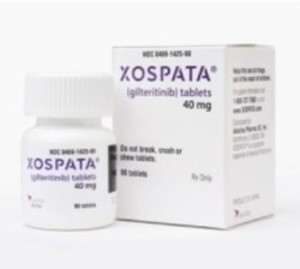Experts rap 4-cycle restriction on Xospata reimbursement < Policy < 기사본문 – Korea Biomedical Review

Hematologists denounced the government’s restriction on the period of the health insurance coverage of Xospata (gilteritinib), a treatment for acute myeloid leukemia (AML) that takes effect from March 1.
Limiting the period of Xospata reimbursement up to four cycles is a result of “typical bureaucratic work that would never come out if the government had listened to experts’ opinions, they said.
The government allowed Xospata reimbursement for up to four cycles of treatment.
From March 1, Xospata will be reimbursable as monotherapy to treat patients with FLT3 mutated (ITD or TKD mutations included) AML who did not respond to conventional therapy or who have relapsed.
AML is a very aggressive blood cancer. The median overall survival of AML patients, from the initial diagnosis to death, is less than one year.
FLT3 mutation is common in AML is known to be a representative biomarker of poor prognosis.
Xospata is a targeted therapy that improved the overall survival (OS), compared to salvage chemotherapy, in relapsed/refractory patients with such FLT3 mutations.
The Health Insurance Review and Assessment Service (HIRA) granted benefits only to two cycles of administration of Xospata as remission-inducing therapy in patients who are available for hematopoietic stem cell transplantation with more significant therapeutic benefits.
Considering the preparation period for hematopoietic stem cell transplantation, two additional cycles of Xospata can be reimbursable only if an allogeneic hematopoietic stem cell transplantation has been pre-approved after showing a partial response (PR) to two cycles of Xospata.
In short, patients responding to Xospata can get health insurance benefits for up to four cycles of treatment (four months).
However, hematologists said they could not understand why HIRA limited the reimbursement to specifically four cycles.
The government might have considered the “median treatment period until remission” shown in phase 3 trial of Xospata but using this to limit the maximum reimbursement period is simply absurd, they said.
Xospata won the regulatory nod based on data from the phase 3 ADMIRAL study, which compared the treatment with salvage chemotherapy.
During the median follow-up period of 17.8 months, the median OS in the Xospata group was 9.3 months, significantly longer than 5.6 months in the salvage chemotherapy group. Xospata lowered the risk of death by 36 percent.
During the entire trial, 34 percent showed complete remission or complete remission with partial hematologic recovery (CR/CRh) in the Xospata group, versus 15.4 percent in the salvage chemotherapy group. The median time until the first CR/CRh was 3.7 months in Xospata, and 1.2 months in salvage chemotherapy.
“The median is the median. Some patients achieve CR faster, but others, beyond the point of four months,” a hematologist said. “Then, these patients can’t get health insurance benefits because four months have passed? I don’t understand what evidence the government used to limit the reimbursement for up to four cycles.”
Even in data provided by the Ministry of Food and Drug Safety, it took from a minimum of 0.9 months to the maximum of 16 months to show the optimal CR/CRh in AML patients.
A second hematologist said he was pleased to hear that Xospata will be covered by health insurance because there are few targeted therapy reimbursable for AML treatment in Korea.
But, noticing the four-cycle limit in the reimbursement criteria, he could not help but feel shocked, he said. “I heard a related medical society submitted opinions on Xospata reimbursement. The government’s final decision, despite their opinions, shows that the government did not reflect them at all.”
Xospata is an expensive anticancer treatment, and it is almost impossible for patients to use it without health insurance coverage, the hematologist went on to say. “If the reimbursement for Xospata is cut off just because the treatment exceeded four cycles are like telling the patient to give up treatment,” he said.
It costs about 45 million won ($37,352) annually if a patient uses Xospata without any insurance benefits, according to the Ministry of Health and Welfare.




